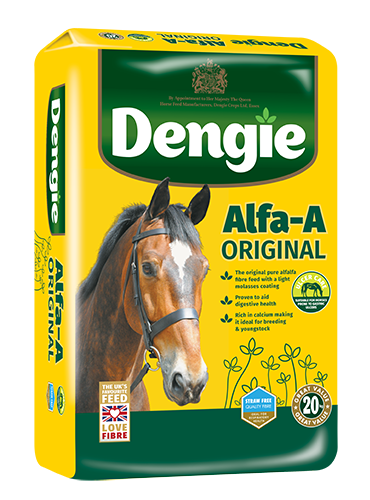Managing nutritional related issues in Thoroughbreds
Although thoroughbred horse nutrition is only one of many factors that influence performance, it is a crucial part as it affects the overall health and well-being of the animal. The unique aspects of racing combined with the genetic and physiological attributes of the Thoroughbred necessitate careful dietary management, particularly in those prone to certain issues. Below we have outlined a thoroughbred feeding guide to assist with managing nutrition related issues.
Gastric ulcers in racehorses
- Alfalfa is an effective buffer to acidity in the gut – alfalfa is abundant in calcium and studies have shown it buffers acidity more effectively than grass based forages making it one of the best horse feed options for thoroughbreds. Just half a scoop of a feed from the Dengie Alfa-A range in each feed will help counteract the acidity produced by feeding cereals.
- Chopped alfalfa provides increased chew time which increases saliva production – saliva contains bicarbonate which also buffers acidity. By regulating the acidity of the horse’s stomach the risk of ulcers is reduced.
- Feed chopped fibre before exercise to stop acid splash – it is recommended not to exercise horses on an empty stomach as there is nothing there to stop the acidic contents of the stomach from splashing around when the horse moves. Using a double handful (200g) of Dengie chopped fibre just before exercise helps to form a fibrous mat to stop the splash
- Omeprazole may reduce calcium absorption – this has been shown in humans and one study has indicated the same is occurring in horses. Whether this is contributing to an increased risk of bone fractures is yet to be confirmed but it is certainly worth providing additional calcium in the ration as a risk reduction strategy. The calcium in alfalfa is highly bioavailable and so easier for the horse to absorb. Just 1 scoop of Dengie Alfa-A Original provides a 500kgs exercising horse with 1/5th of their daily calcium requirement*
- Alfalfa is low in starch – but still provides a good level of energy, especially when combined with oil as part of a thoroughbred horse’s nutrition. Dengie Alfa-A Oil contains the same energy level as many racing rations but with between 5 and 10 times less starch. Keeping starch levels low without compromising on energy intake is key for balancing health, condition and performance
Colic in racehorses
Below we have outlined some of the best horse feeds for thoroughbreds when faced with colic as part of our thoroughbred feeding guide.
- Research has shown peaks in colic incidence occur at different times in flat compared to National Hunt yards. A higher incidence was seen in March and June in flat training yards and September in NH premises. This may well be due to an increase in workload as part of a fitness program accompanied by an increase in cereals feeds which is a risk factor for colic. The cause of the colic wasn’t identified but could also be linked to gastric ulcers which would correlate with an increase in workload for the respective disciplines.
- Meal feeding has also been shown to result in transient dehydration in the gut. Researchers suggest that feeding a few large meals each day can cause sufficient dehydration in the colon to result in impaction which could initiate other forms of very serious colic such as large colon displacement and volvulus.
Feeding strategies to reduce the risk of colic in racehorses
- Use feeds that are high in oil such as Dengie Alfa-A Oil or Performance Fibre as part of the bucket feed to reduce the reliance on cereal based concentrates.
- Use more digestible sources of fibre such as alfalfa and sugar beet included in feeds like Dengie Alfa-Beet – as they are fed soaked they have the added benefit of taking water into the gut thereby countering the potential dehydrating effect of feeding cereals in meals
- Add fibre to slow the rate of intake and passage of cereal based feeds through the gut
- Limit concentrate meal sizes to 1.75kg dividing larger amounts of concentrates into 3-4 feeds daily
Muscle Problems in racehorses (Tying-Up, ERS, Azoturia)
Muscle issues are often multi-factorial and when a “perfect storm” of circumstances occur clinical signs become evident. The balance with a racehorse is providing fuel for fast intense work but trying to keep starch levels as low as possible as high starch intakes are one of the risk factors that can result in muscle problems. It is worth noting that research in Scandinavia has shown that Standardbreds could perform racing level exercise on a fibre based ration without compromising performance or recovery. The researchers suggest that using high quality forages and fibre sources as part of thoroughbred horses’ nutrition would help to compensate for the lack of starch in the ration.
Feeding strategies to reduce the risk of muscle problems in racehorses
- Feed low sugar and starch feeds using fibre and oil as energy sources where possible such as in Dengie Alfa-A Oil or Performance Fibre. These are ideal for feeding when a horse has a rest day as they provide good levels of quality protein, energy and natural vitamins and minerals without the starch found in cereal based feeds.
- Ensure the diet is balanced and that electrolytes are used
Appetite Loss and Fussy Feeders
Tempting the fussy racehorse is a particular challenge when it comes to a thoroughbred horse’s nutrition. Findings from our Senior Nutritionist’s PhD research suggests that hospitalised Thoroughbreds are more likely to go off their feed than other breeds even when gastric ulcers have been ruled out. Interestingly previous studies have also found that Thoroughbreds experience a higher rate of post anaesthetic gastrointestinal complications such as colic, reduced faecal output and colitis compared to non-Thoroughbred horses but the cause has not been determined to date
Feeding strategies for fussy feeders
- Dengie Performance Fibre has been developed to try to tempt even the fussiest horse and has proven to be particularly successful. The inclusion of grass and spearmint oil provide a natural sweetness and tempting flavour respectively
- Feeding several smaller meals can help avoid over-facing the horse.
- Dampening the feed with Dengie Alfa-Beet can also help tempt fussy feeders
- Always introduce new feeds gradually
*Based on NRC guidance for a 500kgs horse in exercise and a calcium level of 1.5% in alfalfa
References
- Hilyer et al (1997) A cross-sectional study of colic in horses on thoroughbred training premises in the British Isles in 1997
- Bulmer et al (2016) The effects of a high-starch or high-fibre diet on equine reactivity and handling behaviour, Applied Animal Behaviour Science
- Jansson and Lindberg (2012) A forage-only diet alters the metabolic response of horses in training
- Lybbert et al (2007) Proceedings of Annual Convention of the AAEP, Orlando, Florida, 2007.
- Swanhall et al (2018) Mineral and Vitamin Supplementation Including Marine-Derived Calcium Increases Bone Density in Thoroughbreds. Proceedings of the Australasian Equine Science Symposium
To find out more information about the best horse feed for thoroughbreds, or for more on our thoroughbred feeding guide, get in touch with our nutrition experts today on 01621 841188.



